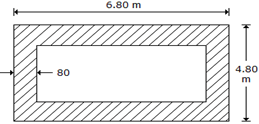This set of Civil Engineering Drawing Multiple Choice Questions & Answers (MCQs) focuses on “Estimate of Single & Double Room Building”.
1. For 100 sq. m cement concrete (1 : 2: 4) 4 cm thick floor, the quantity of cement required, is _______
a) 0.90 m3
b) 0.94 m3
c) 0.98 m3
d) 0.98 m3
View Answer
Explanation: Volume – area * thickness.
So, 100 *.04 = 4 cubic metre, 10% for uneven surface.
4 * 10% = .04 = 4.4cubic metre.
50% for dry mortar, 4.4 * 50% = 2.2.
= 6.6cubic meter.
Cement = 6.6/(1 + 2 + 4) = .94 cubic meter.
2. For the construction of buildings, the subheads of the estimate are ________
a) Earthwork, Concrete work, Brick work
b) Plastering or pointing, finishing, water supply and sanitary work
c) Brickwork Flooring, Wood work, Steel work
d) Earthwork, concrete work, brick work, plastering, water supply and steel work
View Answer
Explanation: This method is suitable for walls of similar cross sections. Here the total centre line length is multiplied by breadth and depth of respective item to get the total quantity at a time. When cross walls or partitions or verandah walls join with main wall, the centre line length gets reduced by half of breadth for each junction. Such junction or joints are studied carefully while calculating total centre line length. The estimates prepared by this method are most accurate and quick.
3. The ‘centre line method’ is specially adopted for estimating?
a) Circular buildings
b) Hexagonal buildings
c) Other geometrical shaped buildings
d) Circular, hexagonal and other geometric shapes
View Answer
Explanation: By center-line method, estimate for earthwork, concrete work or brick work for all walls of the building can be done at a time. If there are junctions, it needs to be carefully calculated deducting the widths. By long wall and short wall method, each wall is estimated separately. In centerline method, it can be prepared quickly eliminating lengthy mathematical calculations. In Center-line method, estimate can’t be physically measured at site where as it can be done for Long wall short wall method. Center-line method is preferred for preparing estimates and long wall short wall method is preferred for entering measurements in measurement book.
4. Referring to the figure below, pick up the correct statement from the following.

a) The total length of centre line of four walls is 20 m
b) Length of long wall out-to-out is 6.80 m
c) Length of short walls in-to-in is 3.20 m
d) Total length of four wall – 20 m, length of short wall – 6.8 m
View Answer
Explanation: Total length is (long wall) 6.80. So, centre to centre length 6.80-80 = 6, 2 wall so 6+6 = 12.
Total length of short wall 4.80. So, centre to centre length 4.80-80 = 4, 2 wall so 4+4 = 8. Total length of center to centre 4 wall = 20 m.
Length of short wall in-to-in is 4.80-(80+80) = 3.20 m.
5. The expected out turn for earth work in excavation in ordinary soil per labourer per day is _____
a) 1 cum
b) 2 cum
c) 3 cum
d) 4 cum
View Answer
Explanation: Sand = 4 cum
Ordinary soil = 3 cum
Compacted soil = 2 cum
Rock = 1 cum.
6. The expected out turn of half brick partition wall per mason per day is _________
a) 1.5 m3
b) 2.0 m3
c) 4.0 m2
d) 5.0 m2
View Answer
Explanation: The out-turn of work per artisan varies to some extent according to the nature, size, height, situation, location, etc., In bigger cities where specialized and experienced labour is available the out-turn is greater than small towns and country sides. In well-organized work less labour is required.
7. The floor area includes the area of the balcony up to _________
a) 50 %
b) 60 %
c) 70 %
d) 45 %
View Answer
Explanation: Carpet Area is the area enclosed within the walls, actual area to lay the carpet. Built up Area is the carpet area plus the thickness of outer walls and the balcony. Super Built up Area is the built up area plus proportionate area of common areas such as the lobby, lifts shaft, stairs, etc.
In architectural, construction, and real estate, floor area, floor space, or floor space is the area (measured as square feet or square metres) taken up by a building or part of it. Gross floor area (GFA) – The total floor area contained within the building measured to the external face of the external walls.
8. The measurement is made for stone work in square metre in case of ________
a) Wall facing
b) Columns, lintels, copings
c) Footings
d) Building work
View Answer
Explanation: Stone blocks used in masonry can be dressed or rough, though in both examples: corners, door and window jambs, and similar areas are usually dressed. Stone masonry utilizing dressed stones is known as ashlar masonry, whereas masonry using irregularly shaped stones is known as rubble masonry. Both rubble and ashlar masonry can be laid in coursed rows of even height through the careful selection or cutting of stones, but a great deal of stone masonry is uncoursed.
Sanfoundry Global Education & Learning Series – Civil Engineering Drawing.
To practice all areas of Civil Engineering Drawing, here is complete set of 1000+ Multiple Choice Questions and Answers.
If you find a mistake in question / option / answer, kindly take a screenshot and email to [email protected]
- Check Civil Engineering Books
- Practice Civil Engineering MCQs
- Check Civil Engineering Drawing Books
- Apply for Civil Engineering Internship
